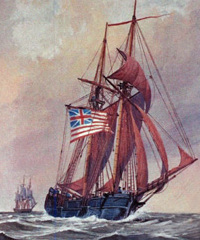USS Wasp (1775)
 The Continental Navy Ship Wasp (note the Grand Union Flag)
| |
| History | |
|---|---|
| Name | USS Wasp |
| Acquired | December 1775 |
| Commissioned | December 1775 or January 1776 |
| Fate | Destroyed, November 1777 |
| General characteristics | |
| Type | Schooner |
| Tons burthen | 189 tons |
| Length | gun-deck 74 ft 10 in (22.81 m) |
| Beam | 24 ft 8 in (7.52 m) |
| Armament |
|
| Service record | |
| Commanders: | Capt. William Hallock |
| Operations: |
|
USS Wasp was originally a merchant schooner named Scorpion, built at Baltimore, and purchased under authority from the
Wasp set sail from Baltimore on 14 January 1776 in company with
Interpreting his orders rather liberally, by ignoring those portions which related to operations in the
The fleet remained at Nassau for about two weeks loading the booty of war. So large was the take that several local ships had to be pressed into service to carry the materiel back to North America. Hopkins' squadron finally hoisted sail on 17 March and set course for
After repairs at Philadelphia, Wasp returned to duty in the Delaware River and Bay. On 5 May, two British men-of-war, the 44-gun Roebuck and the 28-gun Liverpool, entered the bay with several prizes. In the face of these two formidable enemies, Wasp retreated into Christiana Creek, but came out again on the 8th to join a force of galleys in attacking Roebuck after she had run aground. During the ensuing engagement, the Continental schooner captured the British brig Betsey and took her into Philadelphia where the British officers were placed in jail[citation needed].
The schooner continued to operate on the Delaware River and Bay and along the nearby Atlantic coast for the remainder of her career. On 28 June, she engaged in the Battle of Turtle Gut Inlet to salvage the cargo of Nancy.[1] Near the end of the year, she took three more prizes—Leghorn Galley late in October, Two Brothers in December, and an unnamed sloop that same month. She also recaptured Success, an American ship previously taken by HMS Roebuck.
Into the fall of 1777, Wasp continued her operations in the vicinity of the Delaware Capes until November when she and four other ships unsuccessfully engaged the British force under Admiral Sir Richard ("Black Dick") Howe. Philadelphia had already fallen to Admiral Howe's brother, General Sir William Howe, late in September, but American forces retained control of the river below the city until losing that engagement. Following the clash, Wasp was run aground, set afire, and destroyed when her gunpowder exploded.[2]
See also
- List of schooners
- Bibliography of early American naval history
References
- ^ "The Battle of Turtle Gut Inlet". Wildwood Crest Historical Society.
- ^ "Wasp". hazegray.org.
![]() This article incorporates text from the public domain Dictionary of American Naval Fighting Ships. The entries can be found here and here.
This article incorporates text from the public domain Dictionary of American Naval Fighting Ships. The entries can be found here and here.
